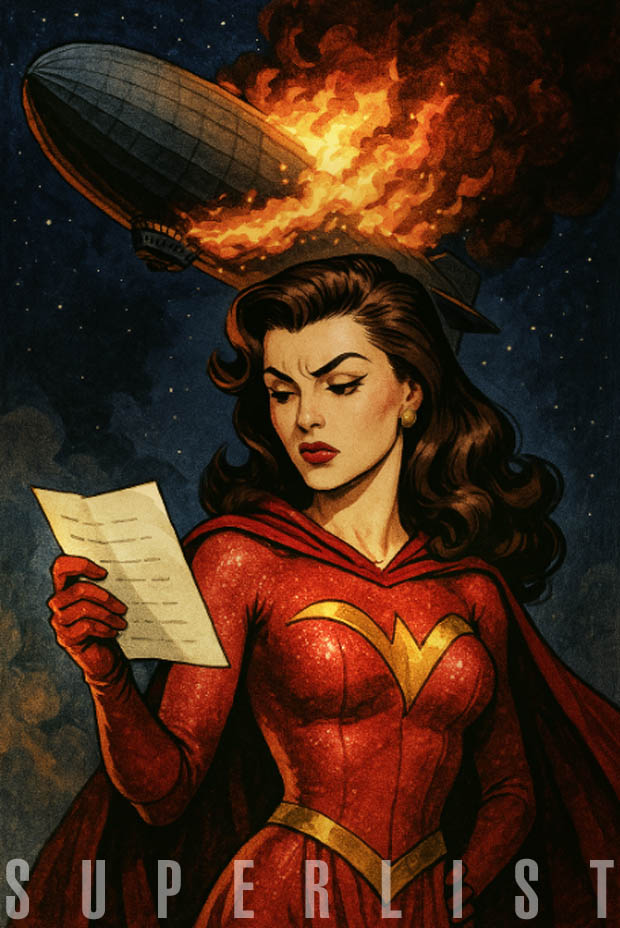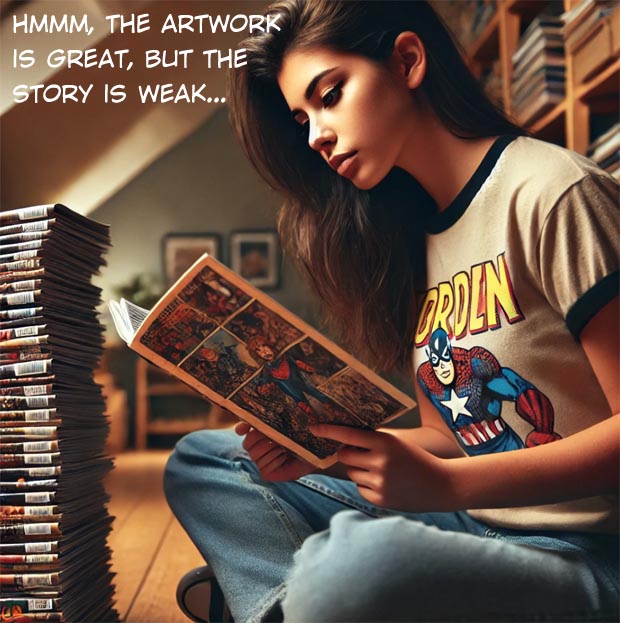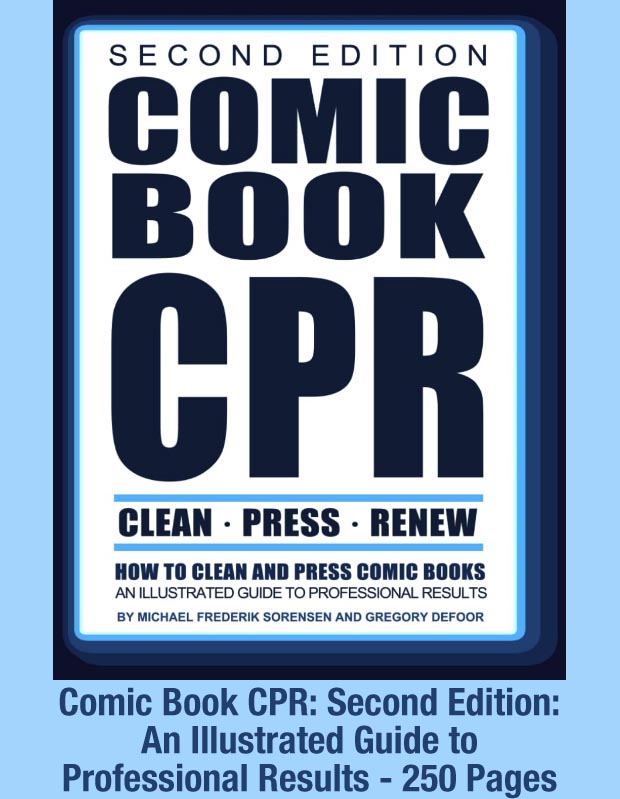Review: Conan the Barbarian #186
Marvel Comics, June 1986
"The Crimson Brotherhood"
Robert E. Howard's warrior has often faced supernatural foes who, at least temporarily, gain the upper hand against an otherwise indomitable and unbeatable hero. In the case of the Crimson Brotherhood, Conan is captured by pirates after a Water Nymph causes the sailing vessel he is traveling on to crash against coastal rocks. Traditionally, in mythological tales of sirens who destroy ships, the sailors are lured by song and unwittingly steer their craft to ruin. Not the case here, in this story by Don Kraar (with art by Mike Docherty), the ship is doomed of its own accord as the crew descends into a screaming panic upon hearing the Nymph's song—suggesting a supernatural compulsion between the Nymph and the wooden craft rather than the usual tragic navigational error.
As powerful as this Water Nymph is, she is, in fact, a damsel in distress—a Conan specialty. The Nymph, Miri, is held captive by a band of pirates led by a vicious and insatiably greedy leader named Kezan Val. Miri is a blue-skinned, white-haired being, shaped exactly like a human woman, dressed in a long, flowing white gown, and speaking fluent English (like Conan!) She is kept chained in a cave at the pirates' hideout and is brought out to sing along the coast, luring ships to their doom so the pirates can loot the wrecks and the dead—and selling survivors to Stygian slavers. Miri clings to the delusion that she can earn her freedom by satisfying Kezan Val’s demands, but that hope has begun to waver.
"Kezan Val captured me and promised to free me if I would lure a score of ships onto the rocks." Page 8, panel 5
Conan arrives in chains after being captured unconscious on the sands of a nearby beach. Though the pirates initially plan to simply sell the muscle-bound barbarian, they soon realize he is also known as Amra—a former captain who once served the late King of Argos (whom Conan himself slew). The name Amra carries weight even among these coastal bandits, but instead of inspiring a rational dose of fear, it instead inspires a higher level of greed. Recognizing the danger of his situation, Conan invokes the Code of the Corsairs, challenging the pirate leader Kezan Val to single combat for leadership. However, Kezan Val rejects the challenge, citing that "a slave in irons" has no standing under Corsair Law. The surrounding pirates also recall that King Thamos, who succeeded the slain monarch of Argos, has placed a substantial bounty on Conan’s head. Seeing a golden opportunity for more greedy gain, the delighted Kezan Val announces his intent to claim the reward.
At this point in the story, we know for certain two things: Kezan Val has no intention of ever freeing the loot-generating Miri, and that by holding Conan in chains in his camp Kezan Val has issued his own death sentence.
That night, held together in the same cave, Miri tells Conan that "only a man without fear" can beak the silver chains that restrain her, and Matt Murdoch not being available, she and Conan then make a deal for mutual release. She reaches up and unbolts the chain around Conan's neck and he then snaps free the ropes tied around his arms, doing something he conceivably could have done earlier and then unbolted his own neck collar. Now free, Conan confirms his arrangement with the still chained-up Miri, but first he wants to deal with Kezan Val. He exits the cave and slips passed the guards in the sleeping encampment of pirates and finds Kezan Val's tent (effortlessly, as if he knew where it was already), and drags the protesting pirate out into the open:
"Come on, you spineless bag of wind and cowardice!" Panel 5, page 11
One of the curious things about Robert E. Howard’s barbarian adventurer is that he is not a true barbarian in the traditional sense—one who rejects the edicts of civilization and lives purely for sensual gratification, with little regard for the past or future. Instead, Howard’s Conan is a hybrid: a man with the physicality and instincts of a barbarian, but possessing the ethical framework and reasoning of a civilized mind—at least within the moral climate of the Hyperborean Age. While he often operates outside the constraints of formal authority, Conan nonetheless adheres to a personal code of conduct. Rather than assassinate Kezan Val in his sleep, Conan stages a public confrontation, ensuring the other pirates witness him defeating their leader according to the "rules of the Corsairs," thereby legitimizing his claim to command.
The ensuing duel lasts but for a few sword swings and then Conan, hurling insults at Kezan Val, punches him to the ground and then kicks him out of the camp, saying "I won't soil good steel with braggart blood." Kezan Val skulks away and Conan assumes leadership of the band of buccaneers. Conan then returns to the prisoner cave and cuts Miri free of her chains, and she tells Conan she'll never forget his deed freeing her, and she vanishes into the nearby waters.
Shortly after, Conan and his pirate crew are aboard their ship and under cheerful blue skies they are told by Conan he is renaming them the "Crimson Brotherhood," but incredibly at the same time Kezan Val is being taken to King Thamos aboard Thamos' own ship. Kezan Val informs the King that Conan has renamed the Corsairs of the Western Coasts "The Crimson Brotherhood," and how he can possibly know this seems to be because he can look across the panels of page 15 and see the drawing of Conan by Mike Docherty doing the renaming, or else Kezan Val has extraordinary powers of clairvoyance. If so, those powers are faulty because King Thamos repays Kezan Val "with his own coin" by rewarding his delivery of this information with treachery, ordering Kezan Val him cut down with swords and tossed to the sharks waiting in the waters around the King's ship.
One of the common criticisms leveled at Howard's Conan stories (and those derived from them) is that Conan represents a patriarchal and misogynistic archetype, embodying the "helpless female rescue fantasy" hated in 21st-century academic discourse and in complete disfavor in published pop-fiction. It's true that the damsels in distress are frequently young and beautiful, but Conan is just as often found rescuing old people, children, horses, and a wide range of hapless or thickheaded peasants. In The Crimson Brotherhood, however, this dynamic is subverted: Conan is ultimately the one who is rescued. In a twist of circumstances, Miri the Water Nymph prevents and destroys King Thamos's fleet of warships from ever reaching Conan's craft for battle—thus repaying the debt she owes the Cimmerian warrior.
The Conan stories are true power fantasies, but they are also—beginning with Howard's originals and all the copies that bother to retain the main moral aesthetics—moral engines exploring questions of right and wrong within the mythological Hyperborean age of Howard’s imagination. Innocence is valued and portrayed as deeply vulnerable; greed and hatred are shown to be corrupting forces; and power, while desirable, is likewise corrupting. This is where Howard often brings the narrative full circle, presenting Conan as both a "barbarian" and a hybridized civilized man. Conan loathes cowardice and hypocrisy—traits he sees as two sides of the same coin.
On the other hand, Conan is also an apologist for raw power. When he meets Miri—who is complicit in the deaths of many men from the very ship he was originally sailing on at the start of Crimson Brotherhood, as well as countless anonymous sailors whose vessels were dashed against the rocks under her song while she served Kezan Val—he does not hesitate to acknowledge the grim calculus of force. Like Alexander the Great, who famously severed the Gordian Knot with a sword rather than solving it through expected means, Conan approaches moral complexity as a series of knots to be cut through—often with steel or bare hands. He is a physical instrument of resolution in a world troubled by deception, betrayal, and violence. Though Miri was a prisoner, coerced into using her powers against innocent seafarers, Conan sees her actions as result of a brutal hierarchy of dominance—a dynamic he understands well from his own periodic experiences as a captive.
Conan is more than a mere contrarian with an anti-hero's code; in Howard’s vision of Hyperborea, he becomes a paradoxical figure—an agent of violence and occasional thief who preys upon victimizers. Howard's Conan stories signal to the reader that the hero is single-purposed to strike a path toward riches and glory, but Howard then traps Conan into perplexities that require the hero to manifest different qualities while remaining a "freebooter." Yet when confronted with violations of the innocent, particularly acts of cruelty, he instinctively identifies with the victim and is compelled to act. Conan’s violence is more a tool than an expression of character flaw, as it would certainly be seen in a 21st century setting, because it is almost always with purpose, often aimed at figures of tyranny, deceit, or cruelty. When he encounters innocence under threat—particularly when he witnesses acts of gratuitous cruelty—he responds not with indifference but with visceral retribution. In these moments, Conan acts as a kind of brutal moral instrument, meting out justice.
It is interesting that, while Howard distances his character from traditional "knightly" attitudes—particularly in matters of sexual morality—this aspect is somewhat muted in the Marvel Comics adaptation of Conan. Nonetheless, Conan reflects the spirit of the "Lost Generation" era in which Howard was writing, a time marked by moral experimentation and the reexamination of traditional values. Combined with Howard’s pop-culture, pulp-fiction interpretation of ancient heroism and saga literature, Conan ultimately circles back to a position not unlike that of the classic knight in terms of how he wields power and violence. He functions as a combination of policeman and priest, though he typically operates completely freelance in this function.
One of the pleasures of reading serialized comic book adventures centered on a recurring hero is that the storytelling, art, and prose are naturally boosted by the reader’s preexisting familiarity with the character. This built-in continuity allows the narrative to build momentum without needing to reintroduce the hero again. In Conan the Barbarian #186, there is little difficulty in following the story—it unfolds in straightforward chronological order, with events progressing clearly from beginning to end. The actions and results do not change Conan; in many tales of heroism the main characters are substantially altered by events, the "hero's journey," but here, as in most issues, the Cimmerian Warrior continues onward, unmoved.
- Story: Don Kraar
- Pencils: Mike Docherty
- Inks; Dave Simons
- Letters: Bill Pearson
- Colors: Ken Feduniewicz
- Editor: Larry Hama
- Editor in Chief: Jim Shooter

Related: More Reviews!
Review: Conan the Barbarian #186 – Conan and a water nymph cooperate on a jailbreak
Batman Family #1, Sept-October 1975 – Batgirl and Robin battle a resurrected Benedict Arnold out to spoil the Bicentennial
Detective Comics #831 - Reforming Harley Quinn June 2007
Brave and the Bold #131, DC Comics December 1976 by Bob Haney with art by Jim Aparo
Review Adventure Comics #423, featuring Supergirl DC Comics Sept 1972
Review: Knight Terrors First Blood #1 DC Comics July 2023
Hell is a Squared Circle by Chris Condon and Francesco Biagini September 2022 AfterShock Comics
Review: Weird Mystery #4, Jan-Feb 1973
The Secret Life of Catwoman, Batman #62, Dec 1950–Jan 1951
The Origin of the Superman-Batman Team - review of World's Finest #94, May-June 1958, art by Dick Sprang
The Spirit Reborn - Review of The Spirit #1, Feb 2007 By Darwyn Cooke
Superman Confidential #1, January 2007 By Darwyn Cooke and Tim Sale
Richard Corben's Edgar Allan Poe – Poe's Haunt of Horror #1, 2006
Bloodstar - 1975 - Richard Corben
House on the Borderland 2000 - by Richard Corben
Review of the Joker Graphic Novel - Brian Azzarello and Lee Bermejo 2003
Review Harley Quinn #55, Feb 2019 - "We'll All Be Home for Christmas"
Edgar Allen Poe Haunt of Horror #1 2006 - by Richard Corben
Original Page May 12, 2025




